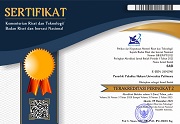Women and Violence In Hibualamo Traditions (An Analysis of Restorative Justice in Resolving Casses of Domestic Violence)
 ), Sri Wiyanti Eddyono(2)
), Sri Wiyanti Eddyono(2)
(1) Faculty of Law Halmahera University, Tobelo, Indonesia
(2) Faculty of Law Gadja Mada University, Yogyakarta, Indonesia
 Corresponding Author
Corresponding Author
Abstract
Introduction: Cases of domestic violence are increasing in Indonesia, this is a manifestation of the unequal power relations between men and women and is also influenced by the culture/customs of the community, one of which is the Tobelo woman in the Hibualamo customs.
Purposes of the Research: This study aims to explain the concept of Restorative Justice in the Indonesian criminal law system and the Restorative Justice Model in Resolving Domestic Violence Cases against Tobelo women.
Methods of the Research: The research method used is a combination of empirical-normative legal research. The approach uses a socio-legal approach (social science) and a statutory approach (statute approach).
Results of the Research: The results of this study include: 1. There is negative labeling of women in Tobelo customary law in the misunderstanding of the Hibualamo concept; 2. The concept of Restorative justice based on Hibualamo ideology which contains noble values that are fair and moral can be the basis for resolving cases of domestic violence in Tobelo to create harmonization and prevent multi-interpretation gaps in the implementation of restorative justice
Keywords
DOI
10.47268/sasi.v28i3.972
Published
2022-10-13
How To Cite
@article{SASI972,
author = {Lilian Apituley and Sri Eddyono},
title = {Women and Violence In Hibualamo Traditions (An Analysis of Restorative Justice in Resolving Casses of Domestic Violence)},
journal = {SASI},
volume = {28},
number = {3},
year = {2022},
keywords = {Women; Hibualamo; Restorative Justice; Domestic Violence},
abstract = {Introduction: Cases of domestic violence are increasing in Indonesia, this is a manifestation of the unequal power relations between men and women and is also influenced by the culture/customs of the community, one of which is the Tobelo woman in the Hibualamo customs.Purposes of the Research: This study aims to explain the concept of Restorative Justice in the Indonesian criminal law system and the Restorative Justice Model in Resolving Domestic Violence Cases against Tobelo women.Methods of the Research: The research method used is a combination of empirical-normative legal research. The approach uses a socio-legal approach (social science) and a statutory approach (statute approach).Results of the Research: The results of this study include: 1. There is negative labeling of women in Tobelo customary law in the misunderstanding of the Hibualamo concept; 2. The concept of Restorative justice based on Hibualamo ideology which contains noble values that are fair and moral can be the basis for resolving cases of domestic violence in Tobelo to create harmonization and prevent multi-interpretation gaps in the implementation of restorative justice},
issn = {2614-2961}, pages = {369--378} doi = {10.47268/sasi.v28i3.972},
url = {https://fhukum.unpatti.ac.id/jurnal/sasi/article/view/972}
}
Journal Article
Coker, Donna. “Domestic Violence and Social Justice.” Violence Against Women 22, no. 12 (October 9, 2016): 1426–37. https://doi.org/10.1177/1077801215625851.
Curtis-Fawley, Sarah, and Kathleen Daly. “Gendered Violence and Restorative Justice.” Violence Against Women 11, no. 5 (May 30, 2005): 603–38. https://doi.org/10.1177/1077801205274488.
Daly, Kathleen. “What Is Restorative Justice? Fresh Answers to a Vexed Question.” Victims & Offenders 11, no. 1 (January 2, 2016): 9–29. https://doi.org/10.1080/15564886.2015.1107797.
Daly, Kathleen, and Julie Stubbs. “Feminist Engagement with Restorative Justice.” Theoretical Criminology 10, no. 1 (February 6, 2006): 9–28. https://doi.org/10.1177/1362480606059980.
Eddyono, SW. “Rancangan Undang-Undang Pidana dan Perlindungan Korban Kekerasan Berbasis Gender.” Jurnal Perempuan (2018) 23 (2) https://lib.ui.ac.id/detail?id=20470379.
surayya Istiqamah, Destri. “Analisis Nilai Keadilan Restoratif Pada Penerapan Hukum Adat Di Indonesia.” Veritas et Justitia 4, no. 1 (2018): 201–26. https://doi.org/10.25123/vej.2914.
Book
Fatahillah A.Syukur. Mediasi Perkara KDRT (Kekerasan Dalam Rumah Tangga) Teori Dan Praktek Di Pengadilan Indonesia. Bandung: Mandar Maju, 2001.
Hendra Kusuma Wardana. "Reformulasi Keadilan Restoratif Dalam Sistem Hukum". Disertasi Fakultas Hukum, Universitas Gadjah Mada, Yogyakarta, 2018.
Hamka Naping, dkk. "Halmahera Utara: Sejarah Perkembangan Peradaban di Bumi Hibualamo." Tobelo :Yayasan Bina Generasi Makasar. 2013.
Marwan Effendy. Teori Hukum Dari Perspektif Kebijakan,Perbandingan Dan Harmonisasi Hukum Pidana. Edited by Referensi ME Center Group. JAKARTA: 2014, 2014.
Tim Departemen Kriminologi FISIP UI, "Viktimologi Reparasi dan Kompensasi Korban Dalam Restorative Justice System". Jakarta : Lembaga Perlindungan Saksi dan Korban (LPSK, 2011).
Thesis, Web Page, and Others
Eddyono,SW. "Urgensi Mempercepat Optimalisasi Dan Efektivitas Pelaksanaan UU No. 23 Tahun 2004 tentang Penghapusan Kekerasan Dalam Rumah Tangga." Kajian bersama Antar Kementerian Pemberdayaan Perempuan dan Perlindungan Anak RI dan Komisi Nasional Anti Kekerasan Terhadap Perempuan didukung oleh UN Women, (JAKARTA: UN Women, 2018).
Komisi Nasional Perempuan. "Korban Bersuara, Data Bicara: Sahkan RUU Penghapusan Kekerasan Seksual Sebagai Wujud Komitmen Negara," 2019. https://komnasperempuan.go.id/catatan-tahunan-detail/lembar-fakta-dan-poin-kunci-catatan-tahunan-komnas-perempuan-tahun-2019.
WHO. “‘Kekerasan Terhadap Perempuan Epidemi Global’,”” VOA Indonesia, 2013. https://www.voaindonesia.com/a/who-kekerasan-terhadap-perempuan-epidemi-global/1686309.html.
Wright, Martin. “CHAPTER 37.” In Roughing It, 238–44. University of California Press, 2019. https://doi.org/10.1525/9780520948068-040.
Cited-By:
1. Restorative Justice Arrangements in Civil Law, Common Law, and Indonesian Legal Systems
Lilian Gressthy Florencya Apituley, Wishnu Agung Baroto, Valentino Dinatra Soplantila
SASI vol: 31 issue: 4 first page: 374 year: 2025
Type: Journal [View Source]
| Dublin Core | PKP Metadata Items | Metadata for this Document | |
| 1. | Title | Title of document | Women and Violence In Hibualamo Traditions (An Analysis of Restorative Justice in Resolving Casses of Domestic Violence) |
| 2. | Creator | Author's name, affiliation, country | Lilian Gressthy Florencya Apituley; Faculty of Law Halmahera University, Tobelo; Indonesia |
| 2. | Creator | Author's name, affiliation, country | Sri Wiyanti Eddyono; Faculty of Law Gadja Mada University, Yogyakarta; Indonesia |
| 3. | Subject | Discipline(s) | |
| 3. | Subject | Keyword(s) | Women; Hibualamo; Restorative Justice; Domestic Violence |
| 4. | Description | Abstract | Introduction: Cases of domestic violence are increasing in Indonesia, this is a manifestation of the unequal power relations between men and women and is also influenced by the culture/customs of the community, one of which is the Tobelo woman in the Hibualamo customs.Purposes of the Research: This study aims to explain the concept of Restorative Justice in the Indonesian criminal law system and the Restorative Justice Model in Resolving Domestic Violence Cases against Tobelo women.Methods of the Research: The research method used is a combination of empirical-normative legal research. The approach uses a socio-legal approach (social science) and a statutory approach (statute approach).Results of the Research: The results of this study include: 1. There is negative labeling of women in Tobelo customary law in the misunderstanding of the Hibualamo concept; 2. The concept of Restorative justice based on Hibualamo ideology which contains noble values that are fair and moral can be the basis for resolving cases of domestic violence in Tobelo to create harmonization and prevent multi-interpretation gaps in the implementation of restorative justice |
| 5. | Publisher | Organizing agency, location | Faculty of Law, Universitas Pattimura |
| 6. | Contributor | Sponsor(s) | Faculty of Law Halmahera University, Tobelo; Faculty of Law Gadja Mada University, Yogyakarta |
| 7. | Date | (YYYY-MM-DD) | 2022-10-13 |
| 8. | Type | Status & genre | Peer-reviewed Article |
| 8. | Type | Type | |
| 9. | Format | File format | |
| 10. | Identifier | Uniform Resource Identifier | https://fhukum.unpatti.ac.id/jurnal/sasi/article/view/972 |
| 10. | Identifier | Digital Object Identifier | 10.47268/sasi.v28i3.972 |
| 11. | Source | Title; vol., no. (year) | SASI; Volume 28 Issue 3, September 2022 |
| 12. | Language | English=en | en |
| 13. | Relation | Supp. Files | |
| 14. | Coverage | Geo-spatial location, chronological period, research sample (gender, age, etc.) | |
| 15. | Rights | Copyright and permissions | Copyright: Authors who publish their manuscripts in this Journal agree to the following conditions: 1. The copyright in each article belongs to the author, as well as the right to patent. 2. Authors can enter into separate, additional contractual arrangements for the non-exclusive distribution of the journal's published version of the work (e.g., post it to an institutional repository or publish it in a book), with an acknowledgment of its initial publication in this journal. 3. Authors are permitted and encouraged to post their work online (e.g., in institutional repositories or on their website) before and during the submission process, as it can lead to productive exchanges, as well as earlier and greater citation of published work. 4. Authors have the right to self-archiving of the article (Author Self-Archiving Policy)
License: The SASI Journal is disseminated based on the Creative Commons Attribution-NonCommercial 4.0 International license terms. This license allows anyone to copy and redistribute this material in any form or format, compose, modify, and make derivatives of this material for any purpose. You cannot use this material for commercial purposes. You must specify an appropriate name, include a link to the license, and certify that any changes have been made. You can do this in a way that is appropriate but does not imply that the licensor supports you or your use.
|
Copyright (c) 2022 Lilian Gressthy Florencya Apituley, Sri Wiyanti Eddyono

This work is licensed under a Creative Commons Attribution-NonCommercial 4.0 International License.
Cited-By:
1. Restorative Justice Arrangements in Civil Law, Common Law, and Indonesian Legal Systems
Lilian Gressthy Florencya Apituley, Wishnu Agung Baroto, Valentino Dinatra Soplantila
SASI vol: 31 issue: 4 first page: 374 year: 2025
Type: Journal [View Source]

 : 3263 times
: 3263 times Download : 1542 times
Download : 1542 times
















